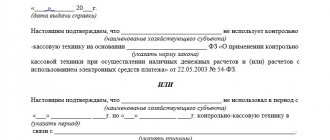Planning cash flows in a company allows you to effectively distribute funds and timely repay current obligations. However, in real practice, quite often there is a temporary lack of funds (cash gap), which is associated with the unevenness of the receipt of money and the discrepancy between the timing of financial inflows and the dates on which expenses must be paid.
A cash gap is an event that is associated with the unevenness of the receipt of money and the timing of financial inflows not matching the dates on which expenses must be paid.
There are various methods for predicting a possible shortage of funds - the cash gap and formulas for calculating and assessing the size and period of the deficit, which allow financial directors to make timely decisions that neutralize the impact of the deficit on payment discipline. A properly organized cash flow planning process allows you to avoid a lack of funds necessary for all payments.
Characteristic features of ineffective financial management and negative ways to eliminate cash gaps in an enterprise or organization are:
- replenishment of the company’s financial resources through short-term loans received from the bank;
- sale of goods and products at a significant discount;
- emergency sale of assets.
The reasons for cash gaps are:
- ineffective budget planning in the company;
- imbalance of budgets and contract terms;
- occasional work with accounts receivable;
- low payment discipline;
- unproductive inventory management technique.
What does a financier need to do to eliminate financial gaps? Cash gaps can be reduced not only by attracting working capital from credit institutions. Often, when analyzing existing business processes, it is possible to identify the company’s internal resources to cover the cash deficit. Let's look at some of them.
Analysis and balancing of contractual terms
An optimal balance of contractual terms helps eliminate the cash gap and also increases the company's profit by reducing the credit burden. To do this you need:
- analyze the terms of concluded contracts for the shipment and purchase of goods for the main activity;
- rank contracts according to the degree of impact on the inflow and outflow of funds;
- compare the ratio of receivables and payables;
- balance the terms of concluded contracts;
- set limits on commodity lending.
Example:
Option 1. Let's consider the impact of the terms of concluded contracts using the example of a trading company, without taking into account inventory balances in warehouses and operating expenses.
The company sold goods on installment payment terms - 20% advance payment in the current month, 30% payment in the next month and 50% in the third month after shipment.
Payment to the supplier is carried out on the following terms:
- raw materials and materials - 50% advance payment 50% next month;
- transportation - 100% prepayment;
- packaging deferment - payment next month.
Figure 1. Excerpt from the company's budget model.
To form planned budget indicators and scenario modeling of processes, it is most convenient to use information systems that allow you to quickly model the optimal option and quickly monitor its implementation. Let's model the conditions of option 1 based on the “WA: Financier” system.
Figure 2. Formation of a sales revenue schedule in the “WA: Financier” system.
Figure 3. Formation of a payment schedule for purchased goods in the “WA: Financier” system.
The ratio of receivables and payables with such planning will be 3.47. The ratio is irrational and indicates an imbalance in the contractual terms. To do this, at the stage of concluding contracts, it is necessary to monitor the ratio of receivables and payables and make every effort to reduce the latter.
A significant predominance of accounts receivable poses a threat to the financial stability of the company and makes it necessary to attract additional sources of financing, and an excess of accounts payable over accounts receivable can lead to the insolvency of the company, which will subsequently affect the attraction of expensive bank loans and loans to ensure core activities.
For companies with seasonal sales, the most advantageous tool for reducing the effect of an increasing credit burden would be a revolving credit line agreement with a repayment date in the months of sales decline. A line of credit allows you not to take out the entire loan amount at once, but to use only that part of it that is needed at a particular moment. In this case, a company with the least risk to its activities can withdraw available funds from circulation in order to repay the loan and go through the procedure for obtaining a new loan.
Option 2. Let's simulate a situation if the company will enter into sales contracts on different terms from the beginning of the year (provided that sales volumes and terms of purchase contracts are maintained).
The company sells goods on the terms of 20% advance payment and 80% payment next month after shipment.
For scenario modeling, it is more expedient to use information systems. For these purposes, you can use the “WA: Financier” system. The system allows you to model planned payment and purchase schedules by period, by counterparty and other analysts, which makes it possible to identify the onset of cash gaps depending on the terms of contracts already at the stage of cash planning.
Figure 4. Modeling of NPV for current activities depending on the terms of contracts (example 1) in the “WA: Financier” system.
Let's consider the balance of accounts receivable and accounts payable at the planning stage, without taking into account inventory balances in warehouses and operating expenses.
Figure 5. Excerpt from the company's budget model.
Figure 6. Balancing the receipts schedule with the sales schedule.
The ratio of receivables and payables will be 2.2. With this planning, the costs of using short-term credit funds are minimized, in contrast to the previous option.
Figure 7. Dashboard of the manager in the “WA: Financier” system.
In conditions when not all buyers comply with their contractual obligations on time, the company's credit burden inevitably increases, which entails a decrease in the absolute liquidity of the company and its creditworthiness. The systematic growth of accounts receivable leads to an increase in cash gaps. The risk of the company's insolvency to meet its obligations increases. In the absence of a unified, balanced method for eliminating cash gaps, this can lead to the financial collapse of the company.
When will the money run out? Or how to avoid cash gaps
Mark Kulikov, an expert in the field of management accounting and planning for small and medium-sized businesses, head of the financial and management reporting group of the group, spoke about how to avoid cash gaps.
When the money runs out, true entrepreneurship begins. Have you heard this? I've encountered a similar opinion a couple of times. They say that the ingenuity immediately kicks in and the entrepreneur begins to cook “porridge from an axe.”
I think differently: when money runs out, stress appears. And stress is not the most pleasant thing. It is better to develop a business with a cool head. A carrot in the front is better than a carrot in the back. When you have a cash gap and you are rushing around looking for money, this is not business development. This is work on its last legs, which clearly does not go together with a sober way of thinking and balanced decisions.
A cash gap is exactly that situation when “there is no money, but you hold on.” That is, you need to pay someone, but there is nothing. And the money may appear tomorrow or in a week. But you need to pay now. In short, this is a very difficult combination to keep a business afloat.
But I will teach you to prevent such situations. This means that you simply won’t hit them.
First of all, it is useful to see the future of your business. No, you won’t have to look into the magic ball, but you will know in advance when and what kind of cash gap you will have. How? There is one magical tool for this - a payment calendar.
The payment calendar is a table with a forecast for the movement of money for each day. Those. Every day you can see how much money came in and how much went out. Consequently, the balance of money is visible in the calendar. They will show you on what day and how much the cash gap will be.
For skeptics, I will add that large companies control their money through a payment calendar. But if you think that this is not for you, then welcome back to the world of intuition and cash gaps.
Six tips for working with such a calendar:
1
It is better to keep a calendar in advance, that is, you fill it out just for the next month, and do not look at what is happening with the current one. For most people, such forecasting is enough to avoid ruptures. If he does appear on the horizon, then you will have time to deal with him. A longer forecast is needed for seasonal businesses and or businesses with a longer transaction cycle. (longer than a month).
2
The forecast is based on your contracts and agreements. There is no intuition here, only facts are taken into account: signed contracts and agreed deliveries are entered into the calendar.
3
The calendar does not always turn out right the first time; sometimes it may not coincide with reality. Here, like at school, you need experience. Each time your hand will become fuller, you will not forget anything, and the calendar will come out more and more accurately.
4
It is better to make the forecast a little pessimistic. If “Petrovich” is constantly delaying payments, then you should not hope that this time he will pay on time.
5
Sometimes receipts from customers are difficult to estimate. Especially if you don’t have a sales plan (or it’s not being implemented). Then consider the receipts of money according to statistics from the past. How much do you sell on average per day or week. And remember about point 3.
6
Update your calendar regularly. A day passed - we updated the balance - we saw how future balances would change. Don't forget to add new information. We concluded an agreement, entered the data into the calendar, and saw the balance change. An out-of-date calendar is useless, this must be understood.
So, a payment calendar helps you keep your finger on the pulse of your business. He predicts possible box office gaps in the future. This means that you will have time to prepare.
However, cash gaps are not the only use of the payment calendar. It shows both a lack and an “excess” of money. Those. that money that can be used in the future either for business development or for paying dividends to shareholders.
The payment calendar template can be downloaded for free from the link in my Instagram profile @mark.finansist. Download, use and carefully monitor your balances.
I wish your business to grow. Scale your strengths and cover your weaknesses. And remember: in any unclear situation, count the numbers. They will help.
Accounts receivable management
An effective tool for reducing cash gaps is timely and high-quality control of the status of accounts receivable. Building a system and regulating work with accounts receivable is one of the key tasks for every company. The main stages of working with it are:
Figure 8. Stages of accounts receivable management.
Monitoring, analysis of current accounts receivable and taking measures to eliminate them.
At this stage, an analysis of indicators of previous periods is carried out in order to timely identify and eliminate the growth of accounts receivable in the future.
- dynamics of growth in accounts receivable;
- capital turnover;
- analysis of the growth rate of accounts receivable over the rate of revenue;
- average monthly percentage of receivables from the total amount of debt;
- ratio of planned and overdue debts;
- ratio of bad and doubtful debts to overdue debts.
Grouping debt by age
- expired;
- doubtful;
- hopeless.
Analysis of the dynamics of overdue accounts receivable makes it possible to identify unreliable buyers and change the term and size of the trade credit.
Development of customer assessment standards
- 1. Before concluding a contract, it is necessary to establish criteria for determining the buyer’s creditworthiness class. The following evaluation criteria can be taken as a basis:
- analysis of creditworthiness at the stage of concluding a contract;
- calculation of absolute and current liquidity;
- equity collateral ratio;
- profitability of products sold;
- Z-analysis using the Altman model;
- buyer's credit history.
- 2. Based on the established creditworthiness class, determine:
- term of provision of trade credit;
- amount of trade credit;
- terms of discounts;
- terms of payment;
- provision of a bank guarantee;
- sale of goods on factoring terms with a guarantee.
- 3. Set criteria for changing the credit class:
- system of discounts for early payment;
- late fees;
- refusal criteria, etc.
Assessment of risks from non-repayment of overdue debt in the future
The risks of non-repayment must include receivables taking into account the rate of inflation and depreciation for the expected time of delay in the collection period, as well as possible losses from non-collection and write-off of receivables.
Development of an employee motivation scheme
Establish standards (KPI) for departments and employees involved in the collection of receivables.
Regulations for working with accounts receivable
- describe business processes, policies, procedures and mechanisms for managing receivables;
- identify standards for assessing buyers and changing the conditions for granting trade credit;
- formulate rules for employee interaction, etc.
Monitoring and analysis of execution
A systematic approach to accounts receivable management helps reduce cash gaps and increase the financial stability of the company. The adoption of any decisions on the management of accounts receivable should be preceded by an analysis of its composition, level and dynamics in the previous period.
How does factoring help SMEs avoid cash gaps?
Micro-enterprises, small and medium-sized businesses usually do not have significant reserves of cash and highly liquid assets; all money is in circulation. Therefore, even short-term financial difficulties can negatively affect payment discipline and lead to cash gaps.
In such situations, factoring comes to the rescue - financing against the assignment of receivables (that is, monetary claims to customers). Having received early payment under the contract from the factoring company, the company returns the money to circulation and promptly “closes” the cash gap.
How do cash gaps arise?
A company can conduct a profitable business and have a large number of assets, but at the same time it does not have “real” money, since the funds are invested in goods, raw materials, real estate, and equipment. As a result, there may not be enough funds to pay salaries or pay taxes - and you cannot postpone such expenses until the money arrives in your account or cash register.
A cash gap is a situation where at a given time a company does not have enough funds to cover all the claims that need to be paid.
. At the same time, a gap between cash receipts and expenses can arise in any organization and does not at all indicate serious financial problems.
If, on a long-term scale, an enterprise operates with a profit, but at the same time cash gaps constantly arise “in the moment,” then the matter may be due to shortcomings in financial policy:
- Ineffective planning of income and expenses
— the problem is solved by introducing a payment calendar, which reflects current and projected income and expenses. Tracking financial indicators and correctly setting payment priorities will help avoid liquidity problems.
- If we are talking about a constant lack of funds, then the issue may be unsustainable financial model of the enterprise
. Reviewing the basic parameters of activity will help prevent the occurrence of cash gaps.
It is within the capabilities of the organization's management to eliminate problems associated with ineffective financial management. However, there are external or systemic factors that are almost impossible to influence:
- Long financial cycle
– when a long period of time passes from the moment of purchasing raw materials and materials until payment is received from customers, during which unforeseen expenses and cash gaps arise. This situation depends on the industry; a long financial cycle is observed in production, construction, etc. The solution to the issue may be prepayments from buyers, but this is not always possible.
- Late payments from customers
. The economic crisis and the consequences of the lockdown have affected the solvency of not only small enterprises, but also large organizations, so payments under contracts do not always arrive on time. This can lead to cash gaps for suppliers and contractors.
Read more about solving this problem in the article “Why factoring is an effective tool in a crisis”
- A significant part of the funds is “frozen” in accounts receivable
. The SME sector is not able to dictate terms to large customers, as a result of which small businesses often work under contracts with unfavorable deferred payment terms. In such cases, the supplier or contractor spends resources to fulfill the contract, and payment comes after a certain period. During this time, urgent expenses may arise for which there are not enough funds - and therefore cash gaps.
How to deal with cash gaps?
There are not many options for quickly solving the cash gap problem (especially when it has already arisen):
- Small enterprises most often resolve the issue by loans from owners
, however, own funds are limited, and the owner is not always able to quickly repay the company’s debts.
- Keep funds in accounts
in order to prevent cash gaps - the decision is ambiguous. By withdrawing money from circulation in case of financial problems, the company receives less profit. In addition, a very large amount may be needed that the company will not be able to “defer” - for example, if the main customer does not pay the contract on time, the company will currently lose most of its revenue.
- Applying for a loan
requires a significant investment of time, and for a large amount a deposit is required. In addition, if cash gaps have already led to a deterioration in the company’s financial position, the loan may be refused.
We wrote about the features of business lending in the article “What is the difference between factoring and a loan”
- Request prepayment from large buyers
not always possible. When working with small businesses, customers dictate the terms of contracts, and they may either not agree to change the terms of the contract, or request a significant discount from the contract price.
- One of the most convenient and fastest ways to close cash gaps and return money to circulation is factoring
.
Factoring as a means of eliminating cash gaps
Factoring is a financial instrument that is designed to quickly eliminate cash gaps. Its essence is that the factoring company buys receivables from the company and pays for them with “real” money. The company immediately uses the received financing for urgent repayments, thereby eliminating the cash gap. On time, the customer settles his obligations not with the supplier or contractor, but with the factoring company.
Read the article “How to quickly launch factoring in an enterprise” to learn about connecting to GetFinance and the online financing scheme
The advantages of online factoring on GetFinance as a means to eliminate cash gaps:
- Concluding an agreement does not impose any obligations on the company, so factoring can be arranged in advance and used if necessary. There is no need to open an additional current account, maintain turnover or pay for using the system - only the factoring commission is charged for the funds actually issued.
- No collateral or guarantee is needed, so factoring is suitable for small and medium-sized enterprises, where often the only liquid asset is accounts receivable.
- Financing is issued as quickly as possible: money is transferred within 24 hours after the register is approved, which means the cash gap can be quickly eliminated.
- Factoring is suitable even for enterprises with an unstable financial situation, since the assessment takes place on the customer, and not on the supplier or contractor.
- You can receive an advance payment for contracts that have not yet been executed, if you need funds for the purchase of raw materials, payment for services (factoring of future requirements, or pre-purchase).
Even companies that are successful in the long term and do not have financial difficulties, in the current period may face cash gaps and, as a result, a liquidity crisis. Small and medium-sized businesses are least protected from such problems. When all the funds are invested in the business and there are no serious reserves of money in the accounts, one late payment from a customer under a large contract or a short decline in sales is enough for cash gaps to arise.
Factoring is an effective financial tool that allows you to prevent and quickly eliminate cash gaps, preventing problems with payment discipline. At GetFinance, the procedure for submitting an application, concluding an agreement and issuing financing takes place completely remotely, which ensures ease and high speed of factoring processing.
To submit a request for online factoring, use the special form on the website or contact a GetFinance specialist by phone 8 .
Classification of payments by priority
A mechanism for eliminating cash gaps is also the classification of payments by priority. Payments can be classified depending on the item, the period of the unfulfilled document, the group of counterparties, the significance of the project or other analytical aspects. Articles with the highest priority are paid without fail, while articles with lower priority are subject to additional conditions. This will allow you to optimally balance the payment calendar, as well as identify sources of funding to cover payments with lower priority.
To automate the management of cash gaps, you can use the “WA: Financier” system. The system has a built-in mechanism for ranking payments by priority. Distribution between company or holding accounts is made directly in the payment calendar in drag&drop mode. By moving lines with amounts across the payment calendar, the user receives online a new state of the payment calendar with recalculated balances and immediately sees possible cash gaps. Having received a payment distribution option in which there are no cash gaps or are completely minimized, the treasurer confirms the changes, and each application for spending funds is assigned a new payment date and its own current account (cash).
Figure 9. Balancing the payment calendar in the “WA: Financier” system.
The method for ranking payments depends on the company’s policy, the size of the card file, and other factors. To develop a methodology, you can conduct an ABC analysis of factors depending on turnover and the magnitude of the impact on the growth of cash gaps.
Coming out of the box office gap? Implement a payment calendar
If you didn’t like all this hassle with the cash gap, work proactively so that you don’t end up in such situations again. A tool called “payment calendar” will help you with this. In it, entrepreneurs plan the cash flow of the business in advance.
Enter forecast receipts and disposals for a month in advance into the payment calendar - and you will be able to see in advance when a cash gap will occur and by what amount. You will have time to take action and prevent such a situation from happening.
Cover photo: Kelly Sikkema/unsplash.com
Inventory Management
The optimal approach to inventory management is to balance the sales budget with the purchasing budget and maintain inventory levels for uninterrupted shipment of products. But often, this balance is not maintained, which leads to an increase in illiquid inventories. In order to improve the efficiency of inventory management, it is necessary to:
- 1. Plan purchases with detail by product groups and product items;
- 2. Determine the optimal amount of inventory (current, insurance) for each type of product group;
- 3. Carry out operational control of the actual availability and condition of inventories;
- 4. Promptly respond to changes in the sales plan (adjustment of the purchasing plan);
- 5. Develop a methodology for analyzing and working with illiquid inventories;
- 6. Manage risks:
- promptly assess factors related to the likelihood of a price increase or decrease, the feasibility of hedging and concluding forward transactions;
- respond to increases in purchasing prices;
- take into account currency exchange rate fluctuations;
- include the amount of overhead costs in the cost and profitability of the goods sold, taking into account lending, etc.
- 7. Develop a motivation scheme and establish inventory management performance indicators (KPI);
- 8. Develop standards for evaluating suppliers. The following can be used as key assessment indicators:
- quality of supplied products;
- history of delivery delays;
- the price of the supplied products;
- providing discounts, trade credit.
Effective inventory management allows the company, on the one hand, to satisfy customer expectations, on the other hand, to minimize storage costs, which helps free up cash and maximize net profit. When developing an inventory management model, it is necessary to rely on the company’s strategic plans, inventory balancing, and determine efficiency criteria (cost minimization, stability of demand, etc.).
Figure 10. Optimization of inventory.
Search for alternatives
Alternative solutions to cover temporary cash gaps may also include:
- obtaining a trade loan from a supplier;
- encouraging customers to pay bills early.
For holding companies, alternative options for reducing cash gaps may be:
- 1. Creation of a centralized treasury (Settlement Center), which will achieve the following indicators: optimize the use of working capital for the holding;
- reduce the amount of borrowed funds;
- increase the operational efficiency of the company group;
- mobilize the holding's internal resources;
- reduce labor and financial costs;
- consolidate free liquidity in the account of the parent organization and finance payments of holding companies;
- minimize cash gaps.
- reduce logistics costs;
Videos of past webinars on the topic “Money Management”
Look
Features of calculating an existing gap
To identify the size of the gap, you need to generate a cash flow report. If the calculation results in a negative value, it will be the indicator under consideration. It makes sense to conduct an analysis of inventory balances. Based on their size, further actions are determined. In particular, the available balance can cover the needs of the enterprise, which will avoid urgent purchases.
The size of the cash gap is determined according to the information contained in the payment calendar. Let's consider a simplified form of calculations:
DS + PD - PP = ODS
The formula uses the following indicators:
- DS – the amount of money at the beginning of the day in which the operation is carried out.
- PD – the actual amount of payments by debtors.
- PP – payments to suppliers.
- ODS – the balance of money at the close of the day.
A negative result is a serious reason to take urgent measures.










